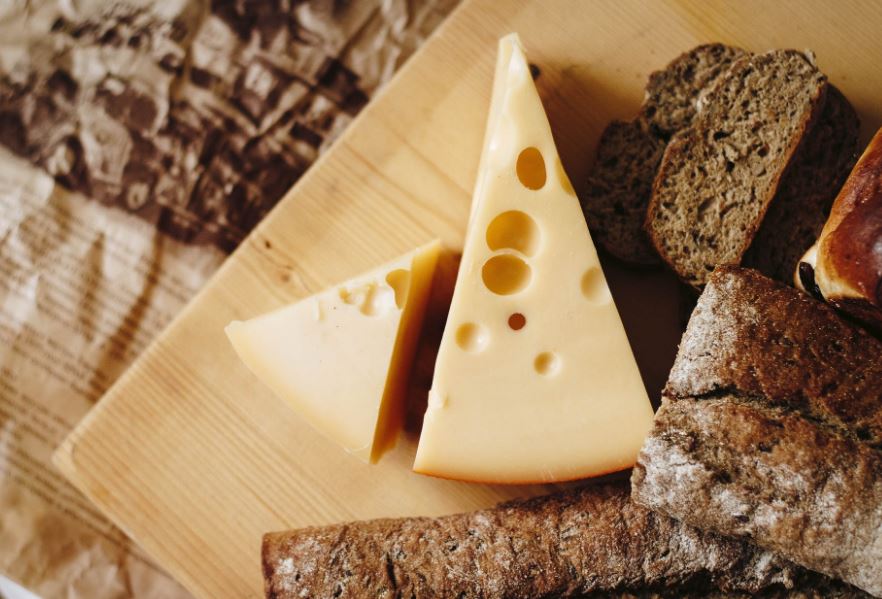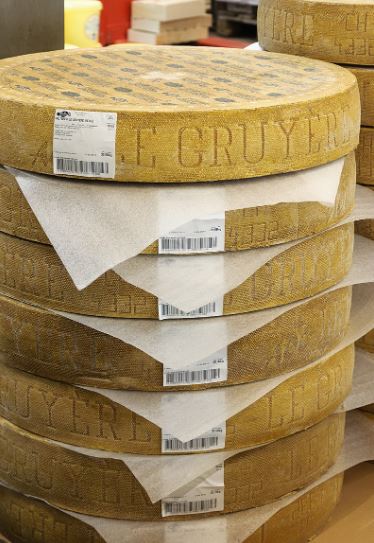Even though it was created a thousand years ago during the Holy Roman Empire, Gruyère cheese is considered a Swiss product (800-1806 AD). A wheel of authentic gruyère should weigh 77 pounds and be at least 22 inches in diameter to qualify as an Appellation d’Origine Protégée (AOP) cheese.
Cheesemakers use rennet to curdle raw cow’s milk in huge copper vats, then squeeze all of the remaining liquid from the generated curds to make gruyère. In temperature-controlled cellars, they press the curds into the round molds and age the wheels for at least five months. Some cheese producers may age gruyère wheels for up to two years.
Learn all about the history of the Swiss Gruyère cheese, one of the world’s most famous melting cheeses, right here.
The Beginnings of Gruyère Cheese
Gruyère cheese has a rich history to match its flavor. This cheese is so delicious and intriguing that countries have gone to war over it! Yes, you read that correctly.
The Identity Crisis of Gruyère
Is gruyère a type of Swiss cheese? Maybe it’s of Austrian origin? Or is it French? It’s difficult to say. Medieval peasants created this type of cow’s milk cheese as a means of survival. It was created in the Swiss mountain town of gruyères (making it Swiss Cheese by its geographic origins).
However, because the town is so near the Franco-Swiss border, many close varieties of cheese made in France, such as Beaufort and Comte, still fall under gruyère’s blanket term. There is another type of gruyère cheese originating on the Austrian side of the Alps to make matters even more complicated. The Austrian variety’s color, taste, and texture are similar to those of the Swiss variety.
Regardless of where it comes from, this sweet, creamy, and nutty cheese is remarkably delicious. This cheese is deserving of its classification; perhaps it is best to allude to gruyère as an Alpine cheese.
The Gruyère War
Few things cause more international strife than cheese. This was one occasion when the Swiss did not stay neutral. For three years, cheesemakers in Switzerland and France competed to see who could make the best gruyère cheese. Both countries claimed exclusive rights to gruyère’s “Controlled Designation of Origin.”
This created a problem because both types of cheese have a distinct appearance and flavor. The French thought they deserved the honor because their cheese was more widely known. The Swiss argued that the cheese was called after a region on their side of the fence and that they had been making it for a longer time.
The debate became so heated that the European Union (EU) was forced to intervene to mediate. The EU ruled in favor of the Swiss because the cheese originated in Switzerland.
The Gruyère Timeline
Gruyère cheese has a long and illustrious history that dates back centuries. Here are just a few of the many highlights of this legendary cheese.
The 12th Century
Since the early 12th Century, the region of gruyère has been developing its namesake cheese. During that time, the area residents discovered a way to make cheese from the surplus milk produced by their cows. They were able to sell their cheese to folks in Italy and France in the end.
The 17th Century
The 17th Century saw the official recognition of the cheese’s regional name. Around this time, the cheese’s exportation began to take off.
As its popularity grew, so did concern for its origins. However, it was not until 1762 that the word indicating its origin was included in the Académie Francaise’s dictionary.
The 18th and 19th Centuries
Many people from the Swiss town of Fribourg immigrated to the gruyère region in the late 18th and early 19th centuries. This movement expanded the geographical production domain of gruyère cheese to include neighboring villages in Vaud, Jura, Neuchatel, and parts of France.
However, no trade protection was in place, and the cheese was frequently imitated. By the mid-19th Century, a campaign to structure trade and fight for the recognition of designations of origin had begun.
The 20th and 21st Centuries
Gruyère cheese debates took place in Madrid (1891), Paris (1926), and Rome (1930). As a result of these meetings, an agreement was reached to safeguard the denominations of goods and their origins.
However, it wasn’t until 2001 that gruyère cheese received the AOC certificate “Controlled Designation of Origin,” which governs the locations and methods of how and where a cheese is made. This includes the Vaud, Jura, Neuchatel, and France regions for gruyère. It was given the same designation for the whole of Europe in 2011.
Uses for Gruyère Cheese
Most gruyère-based dishes highlight the cheese’s ability to become smooth and creamy when heated. Here are several ideas for using the cheese in your cooking:
Cheese Boards
Gruyère is a popular “table cheese,” which refers to cheeses that you can eat in slices. Thinly sliced gruyère can be paired with other cheeses, olives, nuts, fruit jam, dried fruits, and raw honeycomb.
Baked Eggs
Shredded gruyère adds a velvety texture and savory taste to baked egg dishes like quiche, soufflé, or frittata. During baking, the gruyère will melt into the egg mixture.
Fondue
Emmental and gruyère cheese are commonly used in traditional cheese fondue recipes. Dip the cheese mixture with ripped bread, raw vegetables, pickles, or crispy potato wedges.
Dishes au Gratin
Gruyère is one of the best cheeses for cheesy casseroles such as potatoes au gratin, particularly when coupled with grated Parmesan. The gratin method entails sprinkling a dish with cheese, breadcrumbs, or melted butter (or a mix thereof) before broiling it to achieve a crispy brown crust.
Sandwiches
Use gruyère to elevate a simple grilled cheese sandwich. Alternatively, go full French with an egg-topped Croque madame or Croque monsieur, two styles of an iconic hot French sandwich made with layers of gruyère cheese, buttered bread, and thinly sliced ham. The sandwich is pan-fried until crispy, then topped with Mornay or béchamel sauce.
French Onion Soup
Caramelized onions and rich beef stock are combined in this soup, topped with melted gruyère and toasted bread. Home cooks and bistro chefs frequently serve French onion soup straight from the broiler in a ceramic soup crock.




